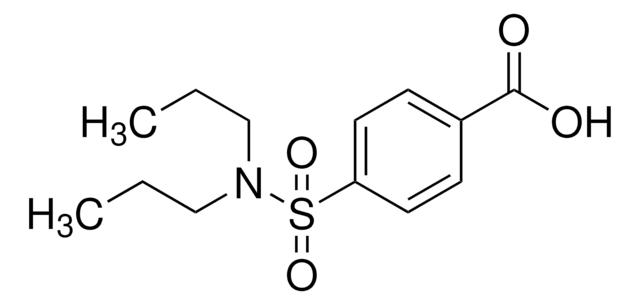L5011
Leukotriene D4
~50 μg/mL (in methanol/ammonium acetate buffer, 70:30, pH 5.6), ≥97%
Synonyme(s) :
LTD4
About This Item
Produits recommandés
Niveau de qualité
Pureté
≥97%
Concentration
~50 μg/mL (in methanol/ammonium acetate buffer, 70:30, pH 5.6)
Conditions d'expédition
dry ice
Température de stockage
−70°C
Chaîne SMILES
CCCCC\C=C\C/C=C\C=C\C=C\[C@@H](SC[C@@H](N)C(=O)NCC(O)=O)[C@@H](O)CCCC(O)=O
InChI
1S/C25H40N2O6S/c1-2-3-4-5-6-7-8-9-10-11-12-13-16-22(21(28)15-14-17-23(29)30)34-19-20(26)25(33)27-18-24(31)32/h6-7,9-13,16,20-22,28H,2-5,8,14-15,17-19,26H2,1H3,(H,27,33)(H,29,30)(H,31,32)/b7-6+,10-9-,12-11+,16-13+/t20-,21+,22-/m1/s1
Clé InChI
YEESKJGWJFYOOK-GKWRKXFUSA-N
Actions biochimiques/physiologiques
Caractéristiques et avantages
Conditionnement
Mention d'avertissement
Danger
Mentions de danger
Conseils de prudence
Classification des risques
Acute Tox. 3 Dermal - Acute Tox. 3 Inhalation - Acute Tox. 3 Oral - Flam. Liq. 2 - STOT SE 1
Organes cibles
Eyes
Code de la classe de stockage
3 - Flammable liquids
Classe de danger pour l'eau (WGK)
WGK 3
Point d'éclair (°F)
49.5 °F
Point d'éclair (°C)
9.7 °C
Équipement de protection individuelle
Eyeshields, Faceshields, Gloves, type ABEK (EN14387) respirator filter
Certificats d'analyse (COA)
Recherchez un Certificats d'analyse (COA) en saisissant le numéro de lot du produit. Les numéros de lot figurent sur l'étiquette du produit après les mots "Lot" ou "Batch".
Déjà en possession de ce produit ?
Retrouvez la documentation relative aux produits que vous avez récemment achetés dans la Bibliothèque de documents.
Notre équipe de scientifiques dispose d'une expérience dans tous les secteurs de la recherche, notamment en sciences de la vie, science des matériaux, synthèse chimique, chromatographie, analyse et dans de nombreux autres domaines..
Contacter notre Service technique









